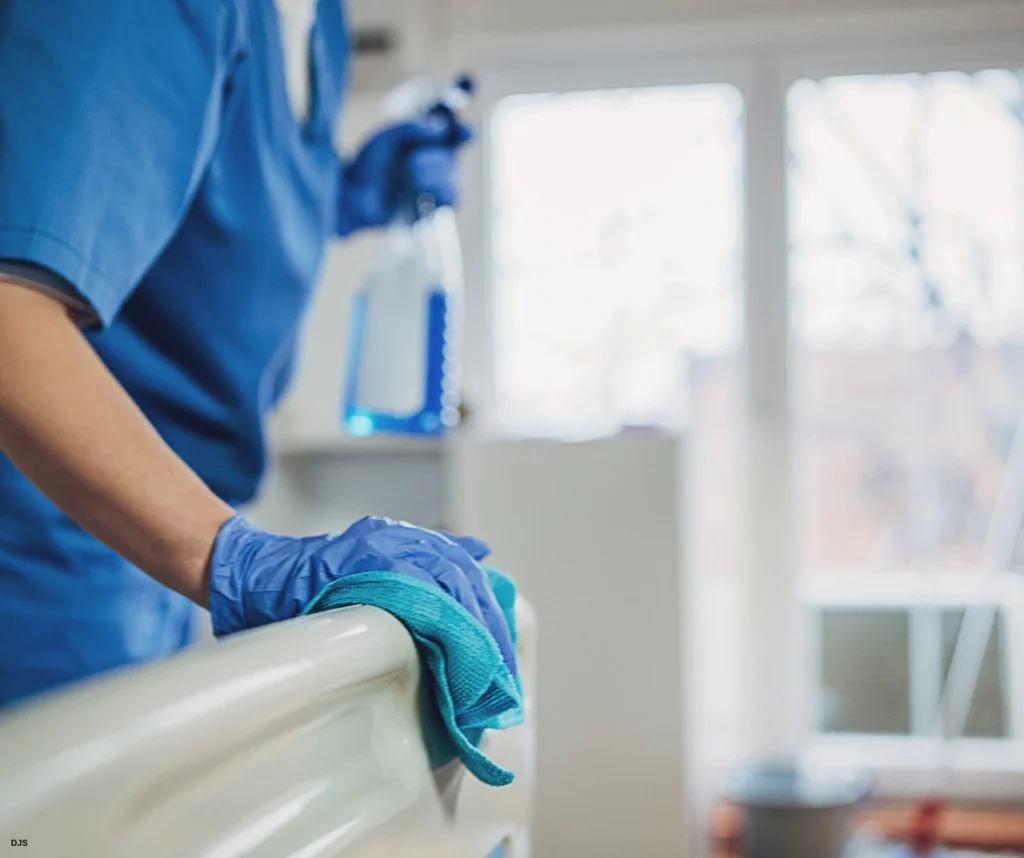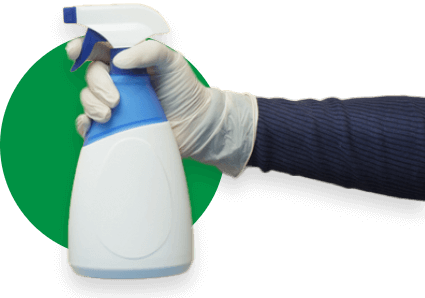Terminal cleaning and operating room procedures prevent surgical site infections through comprehensive daily disinfection protocols. These systematic approaches remove pathogens from every surface, creating sterile environments supporting better patient outcomes. Following AORN and CDC guidelines ensures compliance while protecting patients from healthcare-associated infections.
Steps for Terminal Cleaning Operating Rooms
Terminal cleaning operating room protocols require methodical procedures ensuring complete pathogen elimination after surgeries. These core steps create comprehensive approaches to protecting patients and surgical staff throughout daily operations. Follow this sequence for compliant, effective terminal cleaning:
- Gather essential cleaning supplies and personal protective equipment before entering contaminated operating rooms.
- Develop systematic cleaning plans following strict top-to-bottom, clean-to-dirty workflows, preventing cross-contamination throughout procedures.
- Pay special attention to high-touch surfaces, including light switches, control panels, and door handles.
- Focus on air vents and HVAC systems, cleaning vent covers weekly, removing dust and microorganisms.
- Implement quality control inspections, verifying all surfaces meet disinfection standards through documented checklists systematically.
- Avoid common mistakes, including ignoring dwell times, reusing contaminated wipes, and forgetting hidden areas.
These steps ensure comprehensive pathogen elimination from terminal cleaning operating room environments, protecting subsequent patients.
Our medical facility cleaning services implement evidence-based terminal cleaning protocols following AORN and CDC guidelines. Professional healthcare cleaning teams understand unique contamination risks in surgical environments, delivering consistent results.
What Is Terminal Cleaning in Operating Rooms?
Terminal cleaning operating room procedures involve thorough, methodical cleaning after the surgical staff complete all daily procedures. This process represents complete environmental resets rather than routine maintenance between cases. Every surface, corner, and vent receives attention, eliminating lingering microorganisms throughout spaces.
Microorganisms persist on surfaces between cases, creating infection risks that can be mitigated only through comprehensive terminal cleaning. Even microscopic contamination can lead to infections, jeopardizing patient safety during subsequent procedures. CDC reports indicate that approximately one in 31 hospital patients develops a healthcare-associated infection. Studies show improper operating room cleaning contributes directly to higher infection rates among patients.
Terminal cleaning remains mandatory rather than optional, supported by scientific evidence and regulatory requirements. This specialized healthcare cleaning focuses on infection control rather than general janitorial maintenance. Proper implementation requires trained technicians to understand disinfection science and regulatory compliance standards throughout facilities.

AORN and CDC Guidelines for Operating Room Cleaning
The Association of PeriOperative Registered Nurses establishes clear expectations for terminal cleaning operating room protocols. AORN guidelines include daily floor-to-ceiling cleaning after final procedures using EPA-registered disinfectants. Clean mops and wipes move in single directions without backtracking, preventing contamination spread. Proper storage of cleaning tools prevents contamination between uses throughout multiple cleaning cycles. Documentation tracks compliance, providing accountability and audit trails for regulatory inspections systematically.
AORN terminal cleaning emphasizes thoroughness over speed and consistency over improvisation throughout all procedures. This specialized approach differs from general janitorial work, focusing specifically on infection control. Terminal cleaning isn’t simply custodial maintenance; it represents specialized healthcare cleaning services.
CDC recommendations focus heavily on minimizing healthcare-associated infection risks through comprehensive protocols:
- Airborne Pathogen Control: Cleaning protocols limit airborne contamination during and after terminal cleaning procedures.
- Chemical Effectiveness: Correct disinfectant concentrations and dwell times ensure adequate pathogen elimination throughout surfaces.
- Ventilation System Maintenance: HVAC cleanliness prevents recirculation of contaminated air throughout sterile environments.
- Isolation Procedures: Enhanced protocols activate when contamination or infection outbreaks occur in facilities.
These guidelines emphasize dedicated cleaning supplies exclusively for operating rooms without sharing with other areas.
Both AORN and CDC stress comprehensive staff training, ensuring proper protocol implementation throughout facilities. Checklists remain only as practical as technicians using them, requiring ongoing education programs. Professional training transforms procedures from tasks into infection control strategies, protecting vulnerable patients.
Step 1: Gather Essential Cleaning Supplies and PPE
Effective terminal cleaning operating room procedures begin before technicians spray the first disinfectants, preparing properly. Assembling all necessary supplies and personal protective equipment beforehand prevents leaving contaminated areas. This discipline minimizes cross-contamination risks while ensuring proper tools for complete protocol compliance. Preparation represents non-negotiable components of professional infection control cleaning throughout healthcare facilities.
Personal protective equipment protects cleaning technicians from hazardous material exposure during terminal cleaning procedures:
- Nitrile Gloves: Provide barrier protection against chemical disinfectants and biological contamination on surfaces.
- Fluid-Resistant Gowns: Disposable gowns prevent clothing contamination from splashes during cleaning activities throughout procedures.
- Shoe Covers: Protect footwear while preventing pathogen tracking outside contaminated areas after completion.
- Eye Protection: Goggles or face shields prevent chemical splashes from contacting eyes during disinfectant applications.
- Respiratory Protection: Surgical masks or N95 respirators protect against airborne particles per facility protocols.
These items ensure technician safety while preventing contamination spread during cleaning activities throughout facilities.
Disinfectants and cleaning agents require careful selection, ensuring appropriate pathogen elimination throughout terminal cleaning. EPA-registered hospital-grade tuberculocidal disinfectants provide broad-spectrum effectiveness against most pathogens present. Sporicidal agents eliminate resistant C. difficile spores when specified by infection control protocols. Neutral pH cleaners remove gross soil and organic material before disinfection applications.
Color-coded microfiber cloths prevent cross-contamination between different areas during cleaning procedures systematically. Red cloths designate high-touch areas while blue indicates general surfaces throughout rooms. Yellow cloths clean fixtures, maintaining separation between contamination risk levels. Microfiber flat mop systems with single-use heads ensure floor cleaning without contamination spread.
Two- or three-bucket systems separate cleaning and rinsing solutions, preventing contamination transfer during procedures. Labeled spray bottles ensure proper disinfectant applications throughout all surfaces requiring treatment. Long-handled dusters reach high areas, including vents and ceiling-mounted equipment, without ladders. Stiff-bristled brushes clean grout lines and hard-to-reach crevices harboring contamination throughout spaces.
Waste management supplies include puncture-proof sharps containers, preventing injury during disposal activities. Red biohazard bags and leak-proof bins contain regulated medical waste following protocol requirements. Standard trash liners handle non-regulated waste while maintaining proper segregation throughout facilities.
Choosing appropriate disinfectants requires understanding product specifications and facility infection control protocols. Products must demonstrate low-residue formulations, fast-acting properties, and proven effectiveness against pathogens. EPA’s List N provides approved products effective against SARS-CoV-2 and other resistant organisms. Facilities must verify that products eliminate C. difficile, MRSA, and other healthcare-associated pathogens effectively.
Step 2: Develop Systematic Terminal Cleaning Operating Room Plans
Systematic plans transform terminal cleaning operating room procedures from tasks into scientific processes. Pre-cleaning sweeps remove all waste and movable equipment before disinfection applications begin. This action clears gross contaminants, allowing disinfectants to work effectively on microscopic pathogens. Strict top-to-bottom, clean-to-dirty workflows utilize gravity advantages, preventing contamination of cleaned surfaces.
Pre-cleaning and room preparation methodically clear rooms of movable items and gross contaminants. This crucial phase prepares all surfaces for effective disinfection by removing physical debris. Debris shields microorganisms from disinfectant contact, compromising chemical effectiveness without removal.
Contaminated material removal follows strict containment protocols, minimizing airborne particle dispersal throughout procedures:
- Linen Handling: Roll and contain used linen in designated leak-proof bags, preventing contamination spread.
- Biohazard Disposal: Seal and remove red biohazard bags and sharps containers following facility protocols.
- Single-Use Items: Discard drapes, suction canisters, and disposable packaging in appropriate waste streams.
- Equipment Relocation: Move furniture and equipment outside rooms, allowing unobstructed surface access, especially floors.
These actions prepare environments for thorough disinfection applications throughout all surfaces requiring treatment.
Methodical cleaning sequences apply disinfectants following strict directional paths, ensuring total coverage throughout spaces. Sequences always move from the highest points to the lowest and cleanest areas to the dirtiest. This approach prevents re-contamination of already cleaned surfaces during subsequent cleaning steps.
Ceiling and high fixtures receive attention first, including surgical lights, air vents, and booms. Walls and vertical surfaces follow the working top to bottom throughout all mounted equipment. Horizontal surfaces, including counters, trays, and Mayo stands, receive thorough disinfection applications. Operating tables require meticulous attention, including mattresses, bases, legs, and all attachments. Remaining equipment undergoes cleaning before final floor mopping, completing sequences.
Floor mopping occurs last, starting at points furthest from exits, working backward toward doors. This approach prevents stepping on and re-contaminating clean surfaces during exit procedures. Technicians must never backtrack over cleaned areas, maintaining directional workflow integrity throughout processes.
Disinfectant dwell time represents the most critical and frequently overlooked terminal cleaning component. Dwell time refers to periods disinfectants must remain in contact with surfaces, killing pathogens effectively. Wiping surfaces dry before achieving specified dwell times renders procedures ineffective, providing cleaning without disinfection. This single error can compromise entire terminal cleaning effectiveness despite proper execution otherwise.
Technicians must apply disinfectants liberally enough, keeping surfaces wet for the full manufacturer-specified durations. Most products require three to ten minutes of wet contact time to achieve adequate pathogen elimination. Training programs must emphasize dwell time importance, preventing rushed procedures compromising infection control effectiveness.
Step 3: Pay Attention to High-Touch Surfaces
High-touch surfaces represent superhighways for pathogen transmission throughout terminal cleaning operating room environments. Staff contact these areas most frequently creating direct pathways for microorganism travel. Light switches, control panels, anesthesia carts, keyboards, and door handles require focused attention. Diligent cleaning of these points breaks infection chains preventing transmission between patients and staff.
Key high-touch areas in operating rooms include multiple surfaces requiring specific attention during procedures:
- Access Controls: Light switches and door handles transfer pathogens between numerous individuals throughout shifts.
- Medical Device Controls: Control panels on medical devices and anesthesia machines contact hands during procedures.
- Operating Table Controls: Levers and panels adjusting table positions receive frequent contact during surgeries.
- Waste Management: Trash bin lids and disposal units contact contaminated gloves throughout procedures regularly.
- Technology Interfaces: Touchscreens and keyboards accumulate contamination from repeated finger contact during cases.
These surfaces require separate cloths for each area preventing cross-contamination during cleaning sequences.
Practical disinfecting techniques ensure adequate pathogen elimination from high-touch surfaces throughout terminal cleaning. Spray-wait-wipe techniques provide proper dwell times allowing chemical action before removal. Avoid circular motions that redistribute contaminants rather than eliminating them from surfaces. Wipe in one direction switching cloth sides frequently maintaining clean application surfaces.
Fresh cloths for each distinct area prevent pathogen transfer during cleaning sequences throughout spaces. Once cloths contact surfaces, they must go to laundry bins without returning to solutions. Color-coding systems from supply preparation ensure proper cloth separation maintaining protocol integrity.
Step 4: Focus on Air Vents and HVAC Systems
Operating room air quality represents invisible but critical patient safety components throughout terminal cleaning procedures. HVAC systems and air vents harbor dust and microorganisms circulating throughout sterile fields. Neglected ventilation systems re-contaminate freshly cleaned rooms within minutes posing direct patient threats. Integrating HVAC cleaning into terminal cleaning operating room protocols ensures complete microbial environment control.
Vent cover cleaning occurs weekly or more frequently during flu seasons removing accumulated contamination. Professional duct servicing occurs at least twice yearly maintaining system cleanliness throughout facilities. HEPA-grade filters trap microscopic particles requiring regular replacement maintaining air quality standards. Clean air protects patients while keeping surgical teams alert and comfortable during procedures.
Cleaning procedures for air vents include systematic approaches removing visible and hidden contamination:
- Cover Removal: Remove vent covers accessing internal surfaces harboring dust and microorganisms throughout systems.
- Surface Cleaning: Use microfiber cloths and EPA-approved disinfectants wiping all accessible surfaces thoroughly.
- Duct Assessment: Inspect visible ductwork identifying contamination requiring professional servicing beyond routine cleaning.
- Filter Maintenance: Check filters during cleaning replacing as needed maintaining proper air circulation standards.
These procedures prevent airborne pathogen circulation maintaining sterile field integrity throughout surgical procedures.
Professional HVAC servicing addresses deep contamination beyond surface cleaning capabilities during terminal cleaning procedures. Certified technicians clean ductwork removing accumulated debris and biological contamination throughout entire systems. This comprehensive approach prevents contamination reservoirs compromising terminal cleaning operating room effectiveness over time.
Step 5: Implement Quality Control and Inspections
Quality control inspections provide critical final verification translating cleaning efforts into guaranteed outcomes. Formal inspections ensure accountability confirming technicians followed protocols precisely throughout terminal cleaning procedures. This step identifies areas requiring retraining or process adjustments improving future performance. Without documented inspections, facilities assume room sterility rather than proving it systematically.
Post-cleaning inspection checklists guide supervisors through systematic terminal cleaning operating room reviews:
- High-Touch Surfaces: Check for residue, streaks, or missed spots especially around button seams.
- Medical Equipment: Verify disinfection of movable devices paying attention to wheels, cords, and joints.
- Flooring and Walls: Inspect corners, baseboards, and areas behind permanent equipment for staining or moisture.
- Air Vents: Confirm vent covers are dust-free without dark streaks indicating airflow issues.
- Waste Management: Verify emptied, relined, and wiped receptacles without evidence of leaks or spills.
These comprehensive checks ensure no detail goes unnoticed during terminal cleaning quality verification processes.
Documentation and reporting create clear audit trails for regulatory inspections and internal quality programs. Digital logs or paper checklists require signatures from cleaning technicians and supervisors. This dual verification ensures accountability providing evidence of proper protocol completion throughout facilities. Records support infection control investigations and continuous improvement initiatives identifying patterns requiring attention.
Inspection timing occurs immediately after terminal cleaning completion before room preparation for subsequent cases. This approach allows prompt correction of deficiencies without delaying surgical schedules unnecessarily. Supervisors must verify all checklist items before releasing rooms for next-day surgical procedures.
Step 6: Avoid Common Terminal Cleaning Operating Room Mistakes
Understanding common pitfalls separates adequate terminal cleaning operating room procedures from exceptional infection control. Well-equipped teams can unknowingly compromise sterile environments through frequent errors undermining entire processes. These mistakes often stem from efficiency desires ultimately putting patients at risk unnecessarily.
Ignoring or shortening dwell times represents the most common terminal cleaning error compromising effectiveness. Technicians often spray disinfectants wiping dry almost immediately finishing jobs faster visually. However, inadequate contact time fails killing pathogens like MRSA or C. difficile effectively. Surfaces appear clean without actual disinfection creating false security and hazardous environments. Training must emphasize dwell time as active, non-negotiable steps requiring full manufacturer-specified durations.
Reusing wipes spreads contamination rather than eliminating it throughout terminal cleaning operating room procedures. Technicians using same cloths on multiple surfaces transfer microorganisms between areas actively. Contaminated door handles spread pathogens throughout entire rooms rendering cleaning efforts ineffective completely. Strict protocols require new cloths or clean cloth sides for each distinct area. Color-coding systems prevent contaminated cloth reuse maintaining protocol integrity throughout cleaning sequences.
Using incorrect products or improper dilutions compromises terminal cleaning operating room effectiveness throughout facilities:
- Wrong Products: General-purpose cleaners lack required efficacy against healthcare-associated pathogens necessitating EPA-registered alternatives.
- Improper Dilution: Too-diluted products fail eliminating microorganisms while over-concentrated solutions damage equipment and create hazards.
- Automated Systems: Use dilution systems or precise measuring tools ensuring accurate ratios throughout applications.
Facilities must maintain approved product lists preventing inappropriate chemical selection during terminal cleaning procedures.
Forgetting high and hidden areas creates pathogen reservoirs re-contaminating sterile fields through air circulation. Tops of tall cabinets, HVAC vents, and undersides of tables harbor dust and microorganisms. Movement and air currents dislodge particles causing settlement on sterile fields below contaminating environments. Checklists must explicitly list these areas ensuring technicians clean all surfaces systematically. Extension dusters and articulating-head mops provide tools reaching all areas effectively throughout spaces.
Inconsistent documentation eliminates accountability preventing reliable protocol completion verification throughout terminal cleaning operating room cycles. Staff treating checklists as administrative afterthoughts fill forms from memory rather than real-time. This creates zero accountability cultures without evidence of standard-compliant work completion. Lack of proof becomes significant liability during infection control audits or outbreak investigations. Integration of documentation into workflows requires checking tasks as completed maintaining accurate records.
Terminal Cleaning Operating Room Variations by Facility Type
Different healthcare facilities require adapted terminal cleaning operating room protocols based on surgical volumes and complexities. Facility sizes, procedure types, and patient acuity levels influence appropriate cleaning frequencies and intensities. Understanding variations helps organizations implement effective protocols that match operational characteristics throughout environments.
General surgery centers performing routine procedures follow standard terminal cleaning protocols after daily cases. Operating rooms receive comprehensive cleaning after final procedures using EPA-registered disinfectants systematically. Weekly deep cleaning addresses HVAC systems and less-visible surfaces, maintaining long-term cleanliness standards.
Specialty surgical centers require enhanced protocols for specific procedure types performed regularly throughout operations. Cardiac surgery centers demand meticulous attention given invasive procedures and vulnerable patient populations. Orthopedic surgical facilities need specialized cleaning addressing bone dust and hardware contamination risks.
Ambulatory surgery centers adapt protocols accommodating higher patient turnover with shorter procedure durations. Rapid room turnovers between cases require efficient cleaning without compromising thoroughness or effectiveness. These facilities balance speed with infection control, maintaining patient safety throughout accelerated schedules.
Teaching hospitals coordinate terminal cleaning operating room protocols around training programs and research activities. Multiple surgical teams using rooms throughout days require enhanced cleaning frequencies to prevent contamination accumulation. Academic medical centers maintain the highest standards given complex cases and vulnerable patient populations.
Ensure Expert Terminal Cleaning Operating Room Compliance Today
Terminal cleaning operating room procedures represent critical infection control components protecting patients from healthcare-associated infections. Following AORN and CDC guidelines ensures regulatory compliance while maintaining sterile environments supporting outcomes. Dallas Janitorial Services specializes in healthcare facility cleaning, delivering professional expertise for surgical environments. Contact us today to receive customized cleaning plans specifically designed for your facility.
Frequently Asked Questions About Terminal Cleaning Operating Rooms
What are the AORN-recommended practices for terminal cleaning?
AORN recommends daily terminal cleaning after surgeries using EPA-registered disinfectants throughout operating rooms. Clean cloths for each surface and complete top-to-bottom sanitation protocols prevent cross-contamination. Proper storage of cleaning tools and comprehensive documentation track compliance maintaining accountability standards.
What are the CDC guidelines for terminal cleaning?
The CDC emphasizes disinfectant dwell time importance, air quality control, and supply separation requirements. Cleaning supplies remain dedicated to sterile areas without sharing with non-sterile zones. These protocols prevent healthcare-associated infection transmission, protecting vulnerable surgical patients throughout procedures.







